Preparations for a doomed mission: Evocative images released to mark 98th Anzac Day showing Allied troops landing at Gallipoli
-
•Turkey mission was first major military action by Australia and New Zealand during the First World War in 1915
-
•Gallipoli was a disastrous mission to help the Russians which saw Allies lose 214,000 men - and Australia 8,000
-
•Anzac Cove became focal point for Australian pride after Anzacs were based there for eight months during war
By Mark Duell
PUBLISHED: 01:09, 25 April 2013 | UPDATED: 01:09, 25 April 2013
Landing at Turkey's Anzac Cove in 1915, little did many of these men know that their sacrifices would still be commemorated almost a century later.
These extraordinary pictures were today released to mark the 98th anniversary of the Gallipoli landings on Anzac Day in Australia and New Zealand.
The national remembrance day marks the anniversary of the first major military action by Australia and New Zealand during the First World War in 1915.
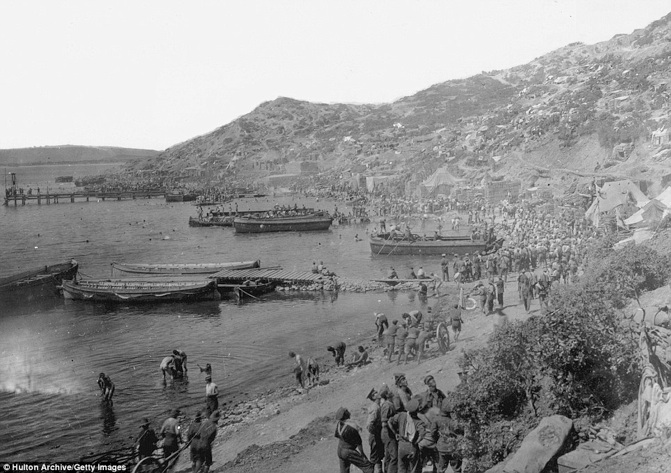
Landing: Allied troops at Anzac Cove in the Gallipoli Peninsula in 1915. From this point many Anzac forces were sent into battle along the ridges of the area
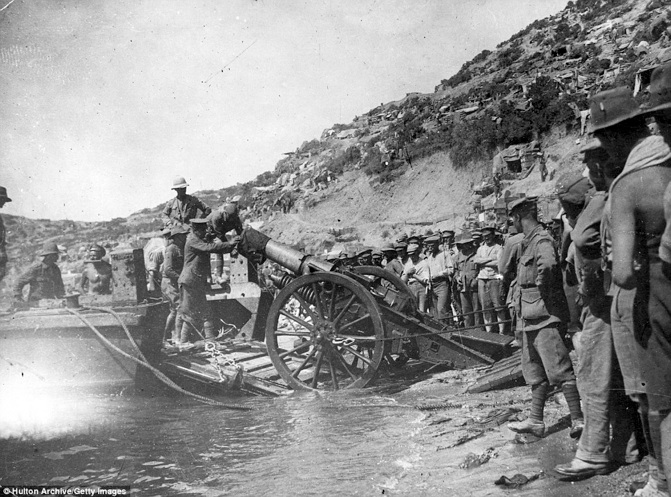
Cannon in place: Troops landing at Anzac Cove in the Dardanelles during the Gallipoli campaign in 1915, which saw the Allies have 214,000 men killed
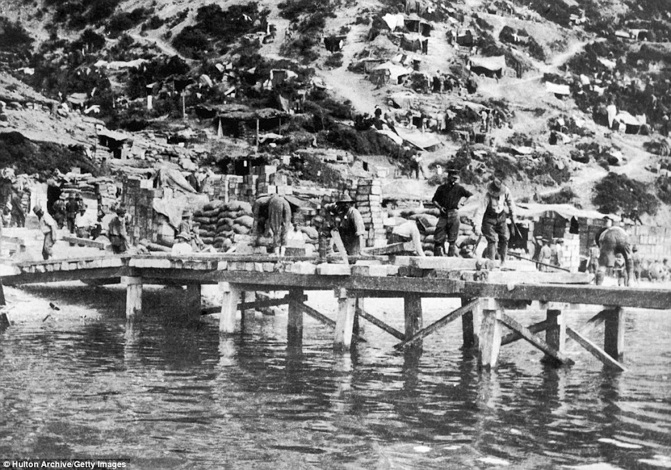
Building: The landing pier constructed by the Allies at Gallipoli in 1915. The background to the Gallipoli landings was one of deadlock on the Western Front
It also now more broadly commemorates all those who served and died in military operations in which the two countries have been involved.
The Australian and New Zealand Army Corps (Anzac) fought alongside their British, French and other allies at Gallipoli in Turkey during World War One.
The background to the Gallipoli landings was one of deadlock on the Western Front in 1915, when the British hoped to capture Constantinople.
The Russians were under threat from the Turks in the Caucasus and needed help, so the British decided to bombard and try to capture Gallipoli.

Fire: A 60-pounder heavy field gun in action on a cliff top at Helles Bay, Gallipoli, Turkey. Today marks the 98th anniversary of the Gallipoli landings

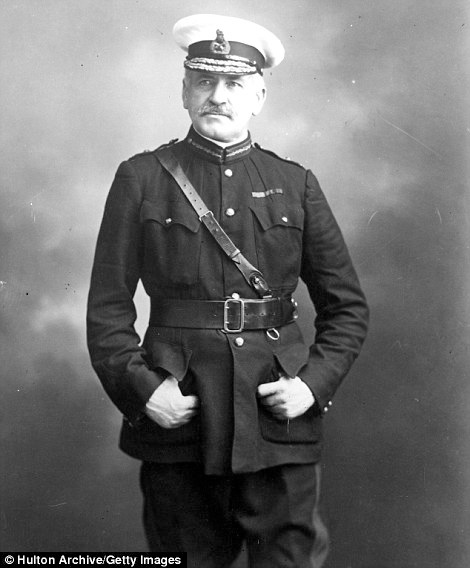
General Sir Ian Standish Monteith Hamilton (left) who led the Gallipoli campaign, and British commander Sir Charles Carmichael Monro (right), who was also involved
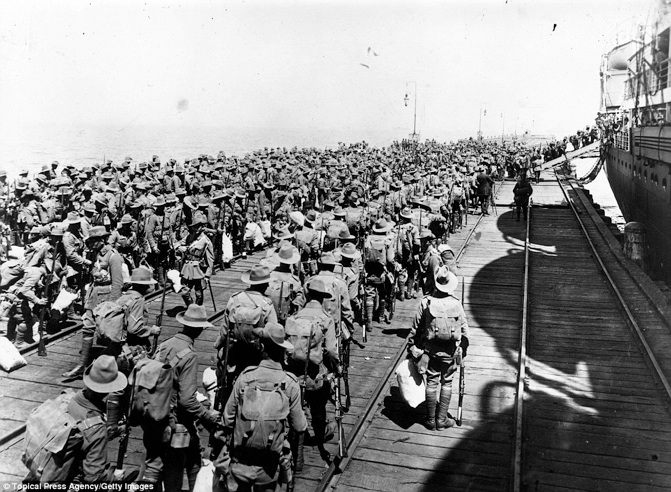
On their way: Australians soldiers embarking at Melbourne to fight in World War One in December 1914. Some 8,000 Australian soldiers died at Gallipoli
Located on the western coast of the Dardanelles, the British hoped by eventually getting to Constantinople that they would link up with the Russians.
The intention of this was to then knock Turkey out of the war. A naval attack began on February 19 but it was called off after three battleships were sunk.
Then by the time of another landing on April 25, the Turks had been given time to prepare better fortifications and increased their armies sixfold.
Australian and New Zealand troops won a bridgehead at Anzac Cove as the British aimed to land at five points in Cape Helles - but only managed three.

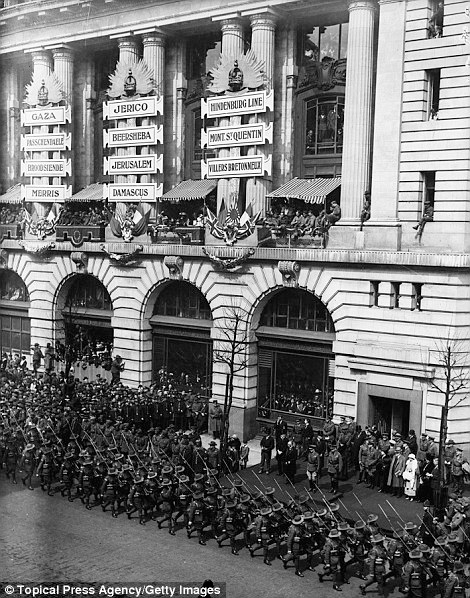
In tribute: New Zealander soldier W J Batt (left) with a regimental mascot at Walker's Ridge during the Gallipoli campaign in Turkey in April 1915, and members of the Australian and New Zealand Army Corps, commonly known as Anzacs, marching through London on Anzac Day four years later in April 1919

Crowds: The Strand, central London, on Anzac day in April 1916, which marks the first major military action by Australian and New Zealand forces during WWI in 1915

Remembrance: An Australian soldier pays his respects as he lays a wreath at the Cenotaph, central London, on Anzac Day in April 1920, five years after Gallipoli
The British still required reinforcements in these areas and the Turkish were able to bring extra troops onto the peninsula to better defend themselves.
A standstill continued through the summer in hot and filthy conditions, and the campaign was eventually ended by the War Council in winter 1915.
The invasion had been intended to knock Turkey out of the war, but in the end it only gave the Russians some breathing space from the Turks.
Turkey lost around 300,000 men and the Allies had 214,000 killed - more than 8,000 of whom were Australian soldiers, in a disastrous campaign.

In silence: People pay their respects at the Anzac Cenotaph during the Anzac Dawn Service at the Martin Place Cenotaph today in Sydney, Australia
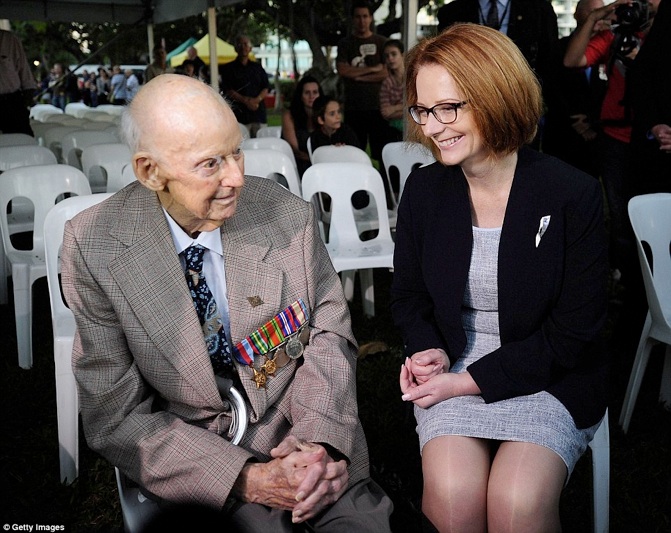
Stories to tell: Prime Minister of Australia Julia Gillard talks with former P.O.W Sidney King at the Aznac Dawn Service today in Townsville, Australia

Memorial: A member of the catafalque party stands at rest during the Dawn Service today in Townsville, marked by veterans, dignitaries and members of the public
Anzac Cove became a focus for Australian pride after forces were stuck there in squalid conditions for eight months, defending the area from the Turks.
The Anzac soldiers who arrived on the narrow strip of beach were faced with a difficult environment of steep cliffs and ridges - and almost daily shelling.
War historian Charles Bean wrote: ‘That strongly marked and definite entity, the Anzac tradition, had, from the first morning, been partly created here’.
MOST READ NEWS
-
•Previous
-
•1
-
•2
-
•Next
-
• Mother-of-two medical director, 38, inexplicably lay down in...
-
•
Published by Associated Newspapers Ltd
Part of the Daily Mail, The Mail on Sunday & Metro Media Group